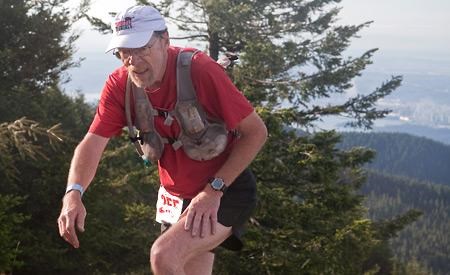Something about Mount Everest seems to attract outdoor enthusiasts and their inner daredevil. Perhaps the draw lies in the tough terrain, breathtaking views, or mammoth 8,848-metre (29,029-foot) distance to the top.
Everest has attracted Rob McWilliam as well, though admittedly he is more of an addicted long-distance runner than a mountain thrill-seeker. The Gillies Bay resident is preparing for the trek of a lifetime this fall when he will take part in the Everest Marathon on December 2, the highest marathon in the world.
While climbers typically challenge Mount Everest on the ascent, marathoners will do the opposite. They will run downward from Gorak Shep, a 5,184-metre (17,000-foot) point near Everest Base Camp, toward the Sherpa town of Namche Bazaar at 3,446 metres (11,300 feet). Beginning at 6:30 am and finishing by 6 pm, runners are in for a challenge.
McWilliam, who has run in 127 different marathons and ultra-marathons, said he was drawn to the event’s unique location. “I’ve done a variety of challenging events, but certainly I’ve never attempted to run at these altitudes,” he said. “That’s where the challenge comes in.”
In order to acclimatize naturally to the change in elevation, runners will embark on a 15-day trek in the area prior to the marathon. In addition to exploring nearby sights, they will hike the marathon route gradually in reverse.
The Everest landscape is a mix of boulders, grass, sandy scree, stone staircases, forested trails and exposed paths along the mountainside. Participants have been told to expect ice and snow at the starting point. The rest of the course is composed primarily of downhill terrain, although it features several steep uphill sections and an exhausting final six miles of undulating trail.
McWilliam found out about the Everest Marathon several years ago after reading a Lonely Planet book containing various adventure ideas. “I was attracted to the intensity of it and just the sheer physical challenge, but then when I started researching more on Nepal and saw how difficult life was there for most people, it seemed a great opportunity to try and raise some money.”
Bufo Ventures Ltd., the British non-profit organization behind the Everest Marathon, donates any profits it makes from the event toward health and education projects in rural Nepal. Over $800,000 has been raised since the first Everest Marathon in 1987.
In addition to paying for travel and entry fees out of their own pocket, many runners also collect pledges to donate to charities of their choice. McWilliam has chosen a Canadian organization, Nepal School Projects, which raises and allocates funds for development in impoverished areas of Nepal.
“I’ve run a lot of marathons for my own satisfaction, but this is a way to give something back,” said McWilliam. “For me, that’s where the payoff comes because I’ll be doing something for other people.”
McWilliam has set up a blog to chronicle the months, weeks and days leading up to his journey.
Readers interested in making a donation to Nepal School Projects, or more information on how funds will be used, can contact McWilliam at 604.486.0377 or [email protected]. Any donation over $25 is eligible for a tax receipt.



